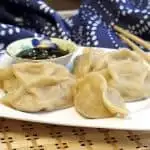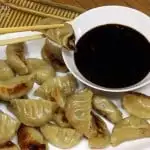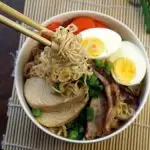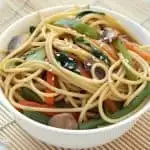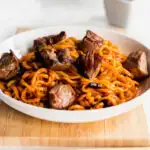Har gow are Cantonese shrimp dumplings that are a classic dim sum. The filling is relatively simple and lightly flavored to let the tasty shrimp flavor shine. While they take a little practice to form, you soon get in the swing of it, and then they cook in no time.

When you think of dim sum, you almost certainly think of dumplings and these steamed shrimp dumplings are one of the most classic dishes that you will find.
They are recognizable by their shiny wrapper that is slightly see-through. They are sometimes called “crystal dumplings” as a result.
What are dim sum?
Modern day dim sum is primarily associated with Cantonese cuisine. It involves serving a range of small plates, often with tea, for brunch.
Many are some kind of dumpling, like shrimp shumai, vegetable jiaozi and pork and cabbage dumplings. You’ll also find soups like wonton soup and egg drop soup, as well as other sides like turnip cake and sticky rice.
The idea has evolved from a practice of giving snacks alongside tea.
During the 10th century, Guangzhou (the main city in Guangdong province, formerly Canton, in southeast China) saw an increase in commercial travel. Tea houses served “yum cha” (“drink tea”) meals with small portions of food.

Yum cha had two concepts. The first was “yat jung leung gin” meaning “one cup two pieces” meaning that traditionally you would be given two small bites with your cup of tea.
The other is “dim sum” meaning “touching heart”, the idea being that the food touches your heart/gives you a taste rather than fills you up.
Dim sum grew in popularity in the 19th century, and the range of dishes that you might find served grew. The idea also spread beyond Guangzhou – these days Hong Kong is probably where dim sum is most popular.
While it is still generally considered Cantonese, with migration both within and beyond China, modern dim sum has much broader influences as well.
You’ll even find fusion dishes, as chefs have become creative, and award winning restaurants serving dim sum.

What are the origins of har gow?
Har gow were apparently created semi by necessity.
They were created on the outskirts of Guangzhou where there was a stream near the teahouse. The chef decided to make some dumplings to use the local shrimp from the stream.
Initially, the wrapper was rice starch but further iterations used wheat starch, which is the core ingredient in the dough today. Most recipes also use part corn starch, tapioca starch or potato starch to help make the dough a little more flexible to work with.
The important part in making the dumpling dough is to add boiling water to the starches, rather than cold or lukewarm. This effectively ‘cooks’ the starch which helps give it the clearer, more delicate texture when you steam the dumplings.
The original har gow recipes used mainly shrimp with some bamboo shoots and pork fat – “har gow” in fact translates as “shrimp dumpling”. These days while most still contain shrimp, you can also get other fillings.
Some say har gow are the measure of how good a dim sum restaurant is. The dumpling wrapper should be delicate but not break when touched with a chopstick and there should be plenty of pleats.
They can be a little more challenging since you really do need to make your own wrappers due to the ingredients being different from other dumpling wrappers, but they are still definitely something you can make at home.

Tips for making har gow
As with many dumplings, the hardest bit is generally forming them. The first few may not be perfect, but you will soon get more confident and find a flow as you make them.
To make these, first make the filling, then set it aside to chill while you make the dumpling dough.
You should use raw shrimp for these as they cook when you steam the dumplings.
Some prefer a smoother filling, with the shrimp chopped finely, or you can leave them more textured, as you prefer. Some will chop some and also include some whole, smaller shrimp.

As mentioned above, the key to making the dough is to use boiling water. Then, mix into the starches and add a little oil. The dough should be soft and malleable, but not sticky.
While there is an amount of water suggested, you often have to work by feel as wheat starch can vary in how much water you need. If it cracks easily when you roll it out, it probably needs more water. If it is sticky, it probably needs more flour.
When filling the individual dumplings, start by dividing all the dough into equal pieces and roll each piece into a ball.
Keep those that you are not working with covered with a damp cloth to avoid them drying out.
You may find it helpful to roll out the dough on a silicone mat to make it easier to un-stick and pick up the dough.
If your dough is dryer, it’s typically best to use the side of an oiled cleaver to press the dumpling dough into a thin circle. If your dough is on the softer side, using a wheat-starch floured surface and rolling pin can work better.

Prepare your steamer before rolling the individual balls of dough and filling them. This way you can place the shaped dumplings directly into the steamer.
If you have steamer liners, use those, or else you can use thin slices of carrot to put each dumpling on to stop them sticking to the basket.
Folding the dumplings
There are a few ways to fold dumplings, but har gow are typically made by forming pleats on one side so that the top of the pleats form a curved crescent on top.

To form the classic folds, you hold the two sides around the spoonful of filling in the middle, then pinch to join on one side.
Then, make little pleats along the one side from that join towards the other side until it is joined all the way along. The pleats all face the same direction.
As you make one dumpling, place it in the steamer and make the next. Make sure they have some space between them for steaming.

Har gow are such a classic dim sum dumpling, that are perfect to serve alongside other dim sum dishes, or whatever you choose.
They would be great as part of a Chinese New Year celebration meal and much more.
Har Gow (Chinese Shrimp Dumplings)

Har gow are Cantonese shrimp dumplings that are a classic dim sum dish.
If your first few dumplings don't turn our just right, don't give up! It can take a few tries to get the hang of pleating them.
Ingredients
For the filling
- 6 oz raw shrimp
- 3 Tbsp bamboo shoots
- 1/2 tsp minced fresh ginger
- 1/2 tsp sugar
- 1/4 tsp salt
- 1/2 tsp sesame oil
- 1 tsp vegetable oil (or other neutral oil)
For the wrappers
- 1/2 cup wheat starch
- 1/3 cup corn starch (or tapioca/potato starch)
- 1/2 cup boiling water
- 2 tsp vegetable oil (or other neutral oil)
Instructions
For the filling
- Depending on how smooth you want the filling mixture, either roughly chop or finely mince the shrimp. Place them in a bowl.
- Finely chop the bamboo shoots and add these, along with the other filling ingredients to the shrimp in the bowl. Mix all together until well combined and slightly sticky. Place in fridge to chill while you make the dough.
Prepare your steamer
- First, prepare the steamer and set some water to start boiling. If you have a bamboo steamer and liners, line the steamer basket(s). If you don't have liners, use thin slices of carrot, spaced apart a little. You could also use a metal steamer with the carrot slices to stop the dumplings sticking, but first you may need to use something to make sure the dumplings will be relatively level and not touch. For the water, either boil some water in the bottom of a wok or use a pot roughly the same diameter as the steamer. Either way, you want enough water to make sure it won't boil dry as the dumplings cook, so a good inch or more depth, but not so much that the steamer will be in the water.
Make the wrappers and fill the dumplings
- For the wrappers, mix both of the starches together in a bowl and then add the boiling water. Mix it to bring it together as a smooth dough. Then add the oil and mix in. The dough should be smooth and flexible but not sticky. If it is a little dry, add a drop or two more water. If sticky, add a little more wheat starch.
- Try to work with the dough while it is still warm. Start by rolling it out into a log then cut into 12 even pieces. Roll each into a ball and place all but one under a damp cloth to stop them from drying out. Take the filling mixture from the fridge and have nearby ready to use.
- If your dough is dryer, you may find it easiest to lightly oil the side of a cleaver and flatten the dough with it. If it is softer, you may want to roll the dough out on a surface lightly dusted with wheat starch. Either way, using a silicone mat can help to work on. Flatten the ball of dough to around a 3.5 - 4 inch diameter circle. Then, carefully work the cleaver/knife under the dough to release it from the surface.
- Place a teaspoonful of the filling in the middle of the wrapper then bring the sides together on either side of it without yet joining them. Pinch together the wrapper on one side then make a small fold on the top of the wrapper and flatten it down, towards the pinched edge, to make a pleat on the one side. Repeat this along the edge of the wrapper - you should get around 6 - 8 pleats, all facing the same way.
- Once joined, transfer the dumpling to the steamer, placing either on the liner or on top of a slice of carrot.
- Repeat with the rest of the dumpling wrappers and filling. Make sure the dumplings have a little space between them in the steamer.
- Cover the steamer with the lid then place over the wok or pot of boiling water. Steam the dumplings for 6 minutes, then serve.
Recommended Products
As an Amazon Associate and member of other affiliate programs, We earn from qualifying purchases.
Nutrition Information:
Yield:
4Serving Size:
3 dumplingsAmount Per Serving: Calories: 181
If you liked this recipe, here are some similar dishes you may enjoy!

Caroline lived and traveled various places before settling in Cambridge, MA. She still fits in some travel with her family, but often settles for traveling through food instead. She shares her recipes at CarolinesCooking.com, where there’s plenty of international inspiration using seasonal ingredients, as well as creative recipes for all to enjoy. Caroline is originally from Scotland, where she grew up hiking and skiing, both things she still loves to do when her two young boys give her a chance. You can follow along with her cooking adventures on Facebook, Instagram, Twitter, and Pinterest.


